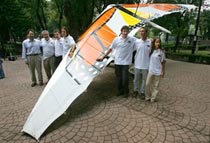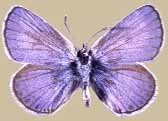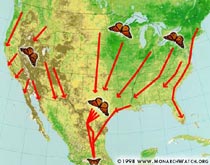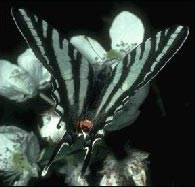| (insert your NIE or newspaper logo here) |
Weekly Online LessonOnline Lesson ArchiveGrade Level: 6-8
|
A Butterfly's Ways
 Beginning
near the end of August, you may spot some orange and black wings flapping
above and around you, flying as if assigned an important mission.
Beginning
near the end of August, you may spot some orange and black wings flapping
above and around you, flying as if assigned an important mission.
Indeed, those Monarch butterflies you'll be seeing are focused on a life-or-death journey.
There are two geographically distinct Monarch populations in North America. The eastern population spends summers breeding east of the Rocky Mountains, primarily in eastern Canada, and spends the winter in Mexico. The western population spends the summer breeding in areas west of the Rockies and overwinters along the California coast.
After summering in northern regions, millions of Monarchs will be spending the next couple of months flying several thousand miles down to either Mexico or our Pacific coastline before the first frost hits.
Every year, hundreds of people watch for these migrants to fly over their towns or alight on nearby trees to rest.
This year, however, some butterfly fans will be watching for something more unusual along the migration route.
On Monday, August 15, 2005, two humans will take off from eastern Canada to fly side-by-side with the Monarchs, using an oversized hang-glider, colored to mimic their native traveling buddies.
 The
crew hopes that this event will give a boost to conservation efforts
for Monarch butterflies. The eastern population has a high risk of becoming
endangered, if illegal logging in Mexico continues at its current pace.
The
crew hopes that this event will give a boost to conservation efforts
for Monarch butterflies. The eastern population has a high risk of becoming
endangered, if illegal logging in Mexico continues at its current pace.
Other butterflies are also in danger due to habitat loss, and some have already gone extinct.
These declines cause concern, because butterflies pollinate flowers. Pollination is critical for producing food, like fruits and vegetables, for animals and humans.
Butterflies are also important to the food chain, because they are eaten by other animals, such as birds and reptiles.
For this week's lesson, you'll learn some butterfly basics, get familiar with a few butterfly species - including the Monarch, and you'll find out how to watch for Monarchs and report your sightings to other butterfly watchers. You'll also discover what other types of butterflies live in your area, and how to identify them.
Butterfly Basics
 Begin
your journey at the Field Museum of Chicago, where you'll learn the
Butterfly
Basics.
Begin
your journey at the Field Museum of Chicago, where you'll learn the
Butterfly
Basics.
First, learn the difference between Butterflies vs. Moths.
About how many species are classified in the order Lepidoptera? In what ways do butterflies and moths differ in their physical characteristics? What are some differences in their behavior?
Click continue to look at some of the illustrations that feature different species of butterflies and moths, and learn more about the Amazing Bodies of these creatures, including variations in their wings, scales and coloration.
Continue to find out more about how they sense their environment. How do butterflies smell and taste? What type of eye do they have?
Next, learn about the Butterfly and Moth Life Cycle. During which stage do they eat and grow the most? What does a butterfly eat or drink at each stage? In what way does the Monarch's journey north differ from its winter migration?
Like all insects, getting eaten by someone else is always a possibility. Though not always foolproof, butterflies and moths do have some Self-Protection against predators.
 Humans
also endanger butterflies, but not because we eat them. It's our demand
for new homes, office buildings, shopping malls and roads that often
destroys butterfly habitat. Therefore, Butterfly
conservation efforts are vital to species survival.
Humans
also endanger butterflies, but not because we eat them. It's our demand
for new homes, office buildings, shopping malls and roads that often
destroys butterfly habitat. Therefore, Butterfly
conservation efforts are vital to species survival.
As you've discovered, Butterfly Habitat is important to butterfly survival, and the best habitat - where a butterfly can feed, rest and reproduce successfully - can vary from species to species.
For example, how do the climates and native species in the Alpine and Arctic compare with those in the Temperate Prairies and Savannas and the Temperate Forest and Woodland areas? How about the Desert and Chaparral regions? The Tropical Lowland Rainforest and the Tropical Mountain Forest?
The Great Migration
 Like
migratory birds, the migratory Monarch butterfly is predictable. We
generally know what route they'll take and when they'll be traveling
from Point A to Point B.
Like
migratory birds, the migratory Monarch butterfly is predictable. We
generally know what route they'll take and when they'll be traveling
from Point A to Point B.
In fact, over the last several years, hundreds of students and others have followed the Monarch Butterfly Migration on its journey south at the Journey North site.
And, even if you don't live along a migration route, you can do it, too!
First, learn How to Track the Fall Migration to Mexico.
You can Count Monarchs Flying Overhead, at a Nectar Source, at an Overnight Roost, or Along the Road.
Keep a daily journal over the next month or two, depending on where you live. If you want to Report Sightings to share with others at Journey North, you will need to register first.
Illustrate your data with a chart or graph. Compare it to that of your friends or classmates. Which type of counting method did you choose?
Also, check out the Fall 2003 migration map to see how the migration sightings moved across the continent. As the sightings get reported this season, compare them with 2003. Did the timing or locations of sightings vary from 2003 or were they about the same?
 While
the Monarch's journey is the longest, other butterfly species migrate
from one area to another at various times of the year, as well.
While
the Monarch's journey is the longest, other butterfly species migrate
from one area to another at various times of the year, as well.
To discover what you might see in your neighborhood this fall, visit the USGS site, Butterflies of North America.
Here, click on your home state to see what species live there. On each species page, you'll find a statewide distribution map that highlights the counties where that butterfly is typically found.
What is the butterfly's preferred habitat? What does it eat as a larva? What does it eat as an adult? Are there any conservation concerns?
Do you remember ever seeing one or more of the species common to your area? Start a butterfly journal, if you'd like, and keep track of what species you've seen, and where and when you saw them.
Once you've identified your local butterfly species, go to the Distribution Maps, choose North America, and locate those species on the list. Each species page will show a map of North America that illustrates the population range of that species.
So, where else do your local butterfly species live? Do you think they live in those other places year-round or seasonally?
Newspaper Activities
Watch issues of The Salt Lake Tribune for any stories about the Monarch migrations or about the life cycle or movement patterns of other butterfly species. Are the butterfly species migrating according to expert predictions? Have butterfly watchers discovered any species not usually common to your area? Is there any news about conservation efforts related to the Monarchs or any other butterflies at risk due to habitat loss or other factors? Also, look for feature stories that explain how people can create special garden areas to attract butterflies.
© Copyright 2005
Learners Online, Inc.
